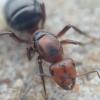I have just recently found a fascination with ants after observing some wild Lasius Interjectus workers. I am mostly attracted to the size and color of the workers and would like to start my very first colony. I understand that L. Interjectus are a parasitic species and typically will take over colonies of L. Neoniger and other species, but is it possible to start a colony all on its own if I capture and introduce L. Interjectus workers or L. Neoniger workers to a newly captured a queen?
Does anybody have experience starting an L. Interjectus colony?
- Formiculture.com
- Forums
- Gallery
- Members
- Member Map
- Chat















